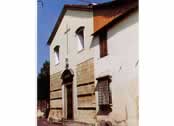
Via Santa Giulitta, 12
The church was once subjected to the Pieve di Santo Stefano. It became Priorate in 1518 and Propositura in 1746. It is already seat of canonical settlements from 1300. In the sixteenth century Monsignor Alessandro de' Medici, the future Pope Leone II, extended and restored the church deeply and kept the Oratory of the Company, now used like the parish theatre. With Romanesque forms, evident especially in the hut front, the church is covered with limestone and travertine, and it has on a side a quadrangular bell tower with single-lancet window of modern times. Inside an only wide trussed aisle, from the entrance on the left wall you can see a wooden bust of Christ, a stone baptismal font, a niche with a nineteenth-century fresco, two stone altars with Sant'Andrea and the Virgin Mary of the Rosary of the fifteenth century, a stone tabernacle of the sacred oil inside frescoed by Antonio Manzi.
Taken out from the Text: Campi Bisenzio by Massimo Biagioni.